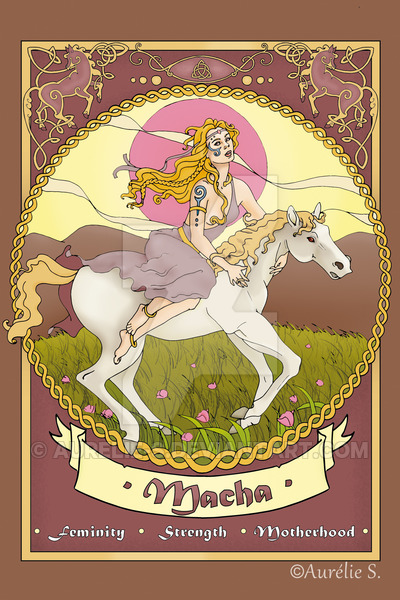Who is Macha?
What we know from myth, history, and inspiration
 "The remarkable, spirited one unbound,
"The remarkable, spirited one unbound,
Loosened the hair on top of her head.
Without a fierce shout driving her,
She came to the racing, to the games...
Though swift the horses of the chief,
Among the tribes strongly apportioned,
The woman was swifter, without effort;
The horses of the king were too slow."
-From The Metrical Dindshenchas (place lore)
Macha is an important Goddess of Sovereignty, especially of Ulster. Her many roles show her ageless power. There are four mythological women or Goddesses named Macha in Irish literature. The name seems to mean "field" connecting her to the prosperity of the land. Emain Macha (pronounced EH-vin MAH-kuh), a real place where the ruler of Ulster lived which you can visit today, is named for her. Horses and crows and ravens are her symbols, much like her sisters the Morrigan and Badb. The three Goddesses worked magic together against the Fir Bolg in the Battle of Moytura. The severed heads of the Fir Bolg were called Macha's Acorn Crop. Macha was Nuada's wife when the two were killed in the Second Battle of Moytura by Balor's deathly eye. However, Macha isn't really dead.
Macha first appeared in Ireland as the wife of Nemed ("Sacred One"). Nemed cleared a plain where Macha died that he named after her. Some say she died of prophetic heartbreak, seeing how the land would be destroyed by the battles told in Tain Bo Cualigne (The Brown Bull of Cooley). Macha is often considered an agricultural Goddess here. Again Macha doesn't stay dead.
Next is the story for which she's most famous. It sets up Ulster for its lack of warriors in Tain Bo Cualigne (The Brown Bull of Cooley). Macha now is an Otherworldly beautiful young woman who silently enters the home of Crunnchu, a wealthy farming widower, and begins caring for the house. She cleans it in a clockwise (sunwise) direction before going to his bed. Crunnchu watches his land flourish as Macha grows bigger with child. Macha is a fertility and prosperity Goddess now.
Her husband goes to the assembly, but Macha warns him not to mention her name. Watching the King's horses race, Crunnchu accidentally says his wife can run faster. The King wants to see this and demands that Macha come to his court. To make sure she'll arrive, the King puts Crunnchu is prison. Macha is nine months pregnant. She asks to give birth first, telling the King and all assembled A mother bore each one of you." No one was moved and they threatened to kill her husband. Macha loosened her hair and ran the race, reaching the pole before the King's horses. Macha then gave birth to twins.
With her dying breath Macha cursed the cruel men of Ulster to be as vulnerable and weak as women in childbirth during the five days and four nights whenever they would need their strength the most. For nine generations her curse would last, causing Cu Chulainn to fight alone in Tain Bo Cualigne (The Brown Bull of Cooley). Macha still refuses to stay dead.
Last Macha is Macha Mongruad or "Macha of the Red Mane." Now she's a warrior queen who is challenged by the five sons of Dithorba. Their father wants to be King and claims that Macha is unfit because she is a woman. When the five brothers were feasting she appeared, looking like a hag and a leper. Still they desired her. She lured them one at a time into the woods and had sex with each them. Macha forced them to build the rath (a circular earthen enclosure) that today is still named Emain Macha. Emain Macha means the twins of Macha.
Artwork by Aurelie Sanchis.